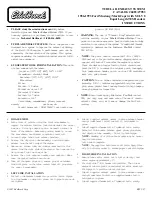
thrown forwards through the vehicle interior
from the luggage compartment.
X
Adjust the head restraints if necessary
(
Y
page 64).
X
If necessary, move the driver's or front-
passenger seat back.
Securing a load
Lashing eyelets
G
Risk of injury
Use only the intended lashing eyelets; on no
account should you use the child-seat anchor-
age points on the rear seat backrest.
Distribute the load on the lashing eyelets
evenly.
Otherwise, vehicle occupants could be
injured by objects being thrown around if you:
R
brake sharply
R
change direction suddenly
R
are involved in an accident
Please observe the loading guidelines.
Observe the following points or guidelines
when securing loads:
R
secure the load using the lashing eyelets.
R
do not use elastic straps or nets to secure
a load, as these are only intended as an
anti-slip protection for light loads.
R
do not route lashing materials across sharp
edges or corners.
R
Pad sharp edges for protection.
There are four lashing eyelets in the luggage
compartment and two in the rear-compart-
ment footwells*.
:
Lashing eyelets in the luggage compart-
ment
:
Lashing eyelets* in the rear-compartment
footwell
Luggage compartment cover*
G
Risk of accident and injury
The luggage compartment cover is not a
restraint system. Secure the load under the
luggage compartment cover by suitable
means. Make sure that the luggage compart-
ment cover is engaged securely. If luggage is
not sufficiently secured, it can be thrown over
the backrest into the passenger compartment
during, for instance, heavy braking, sudden
changes of direction or in the event of an
accident. You could cause an accident or
cause injury to yourself and others.
!
When loading the vehicle, make sure that
you do not stack the load in the luggage
compartment higher than the lower edge of
Loading and stowing
133
Co
ntro
ls
* optional
X204_AKB; 1; 5, en-GB
wobuchh,
Version: 2.11.4
2008-10-15T13:20:56+02:00 - Seite 133
Z
Dateiname: 6515_0671_02_buchblock.pdf;
preflight
















































